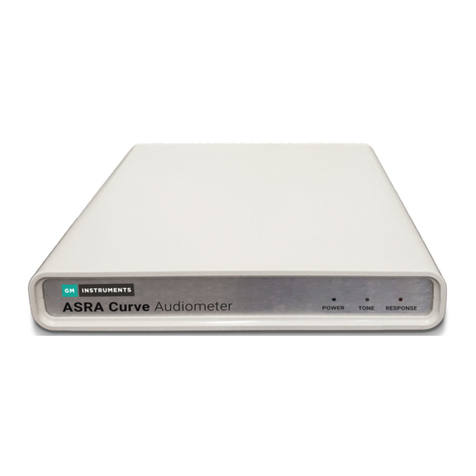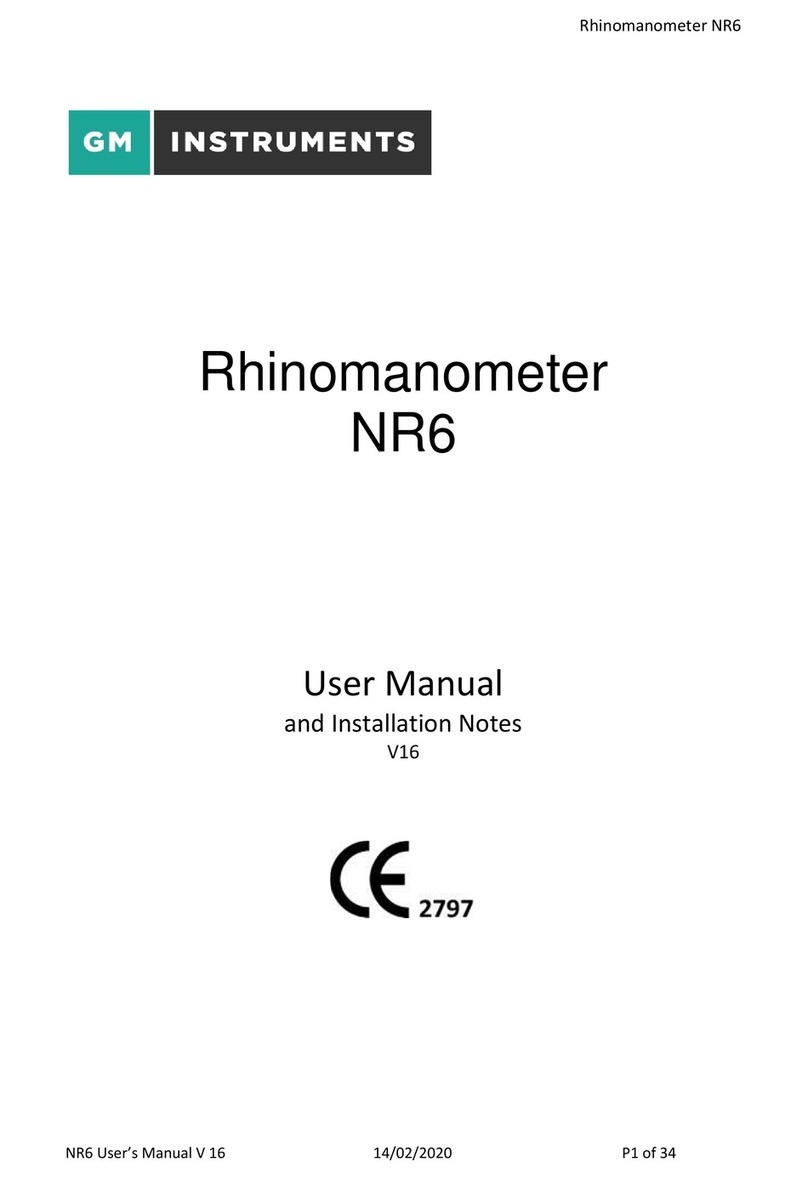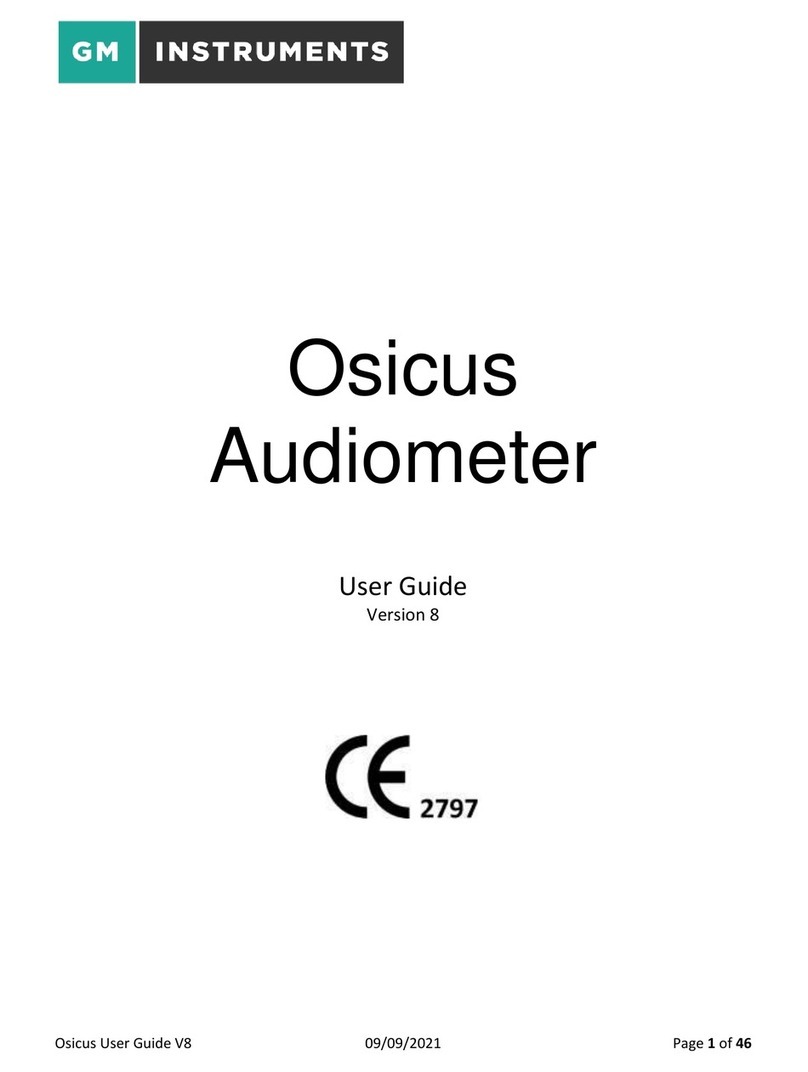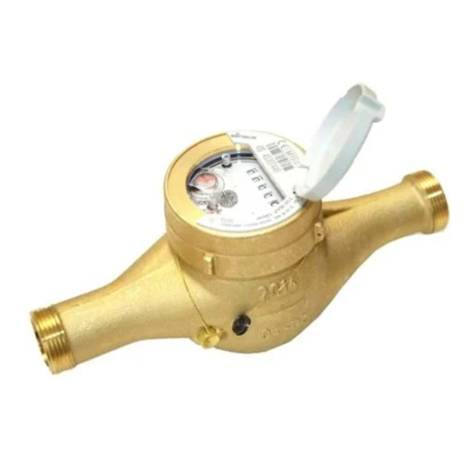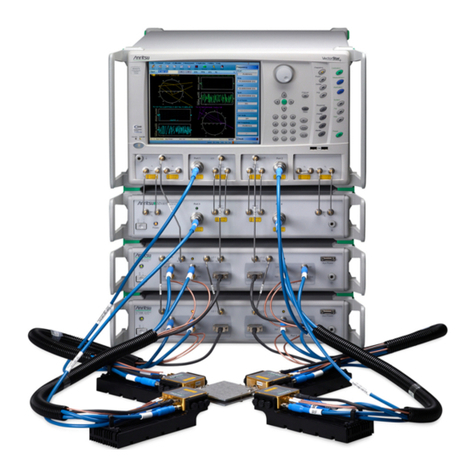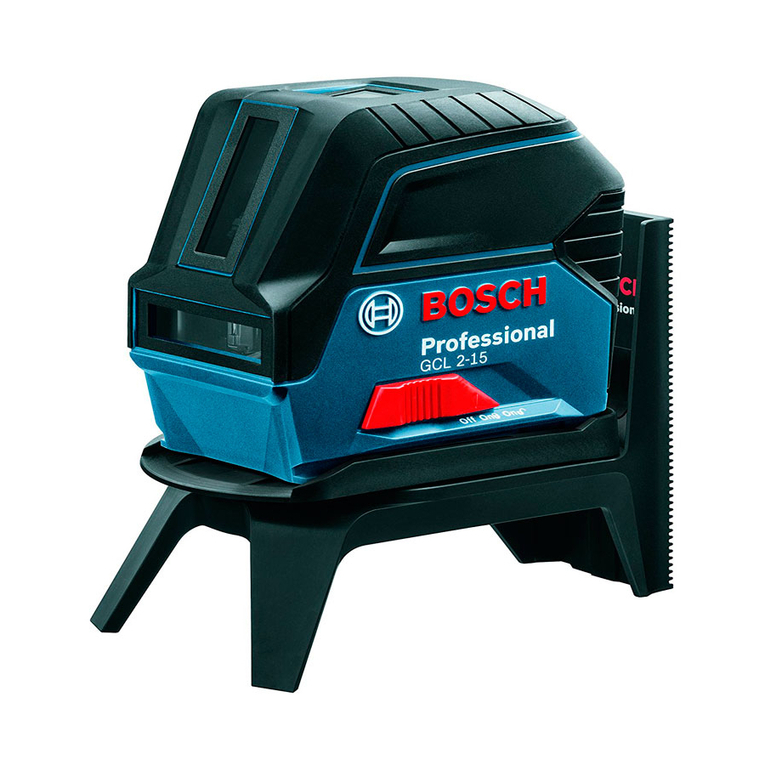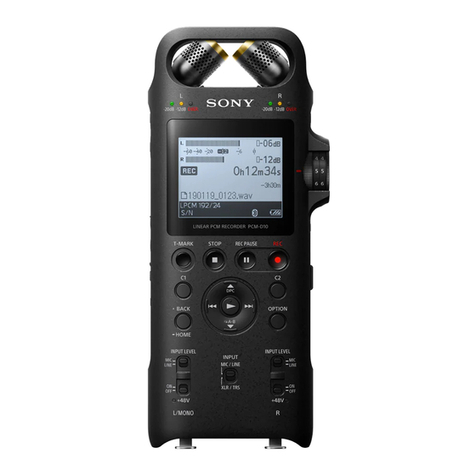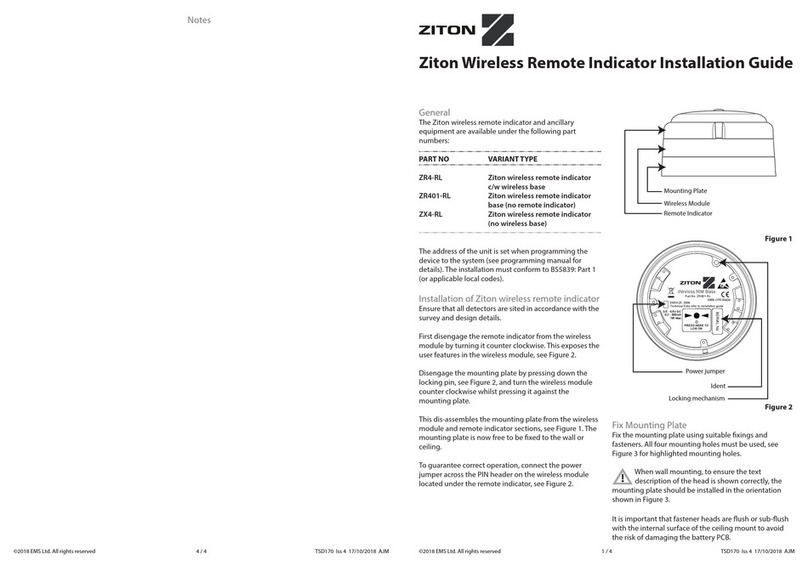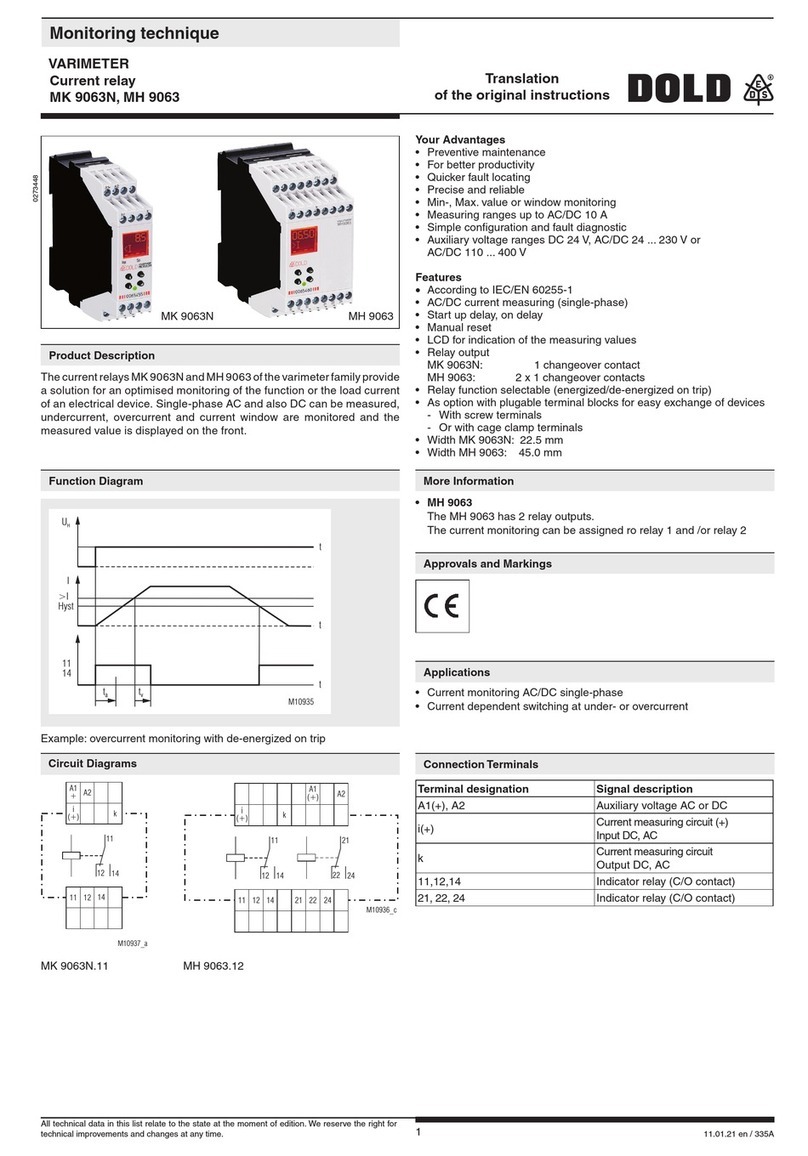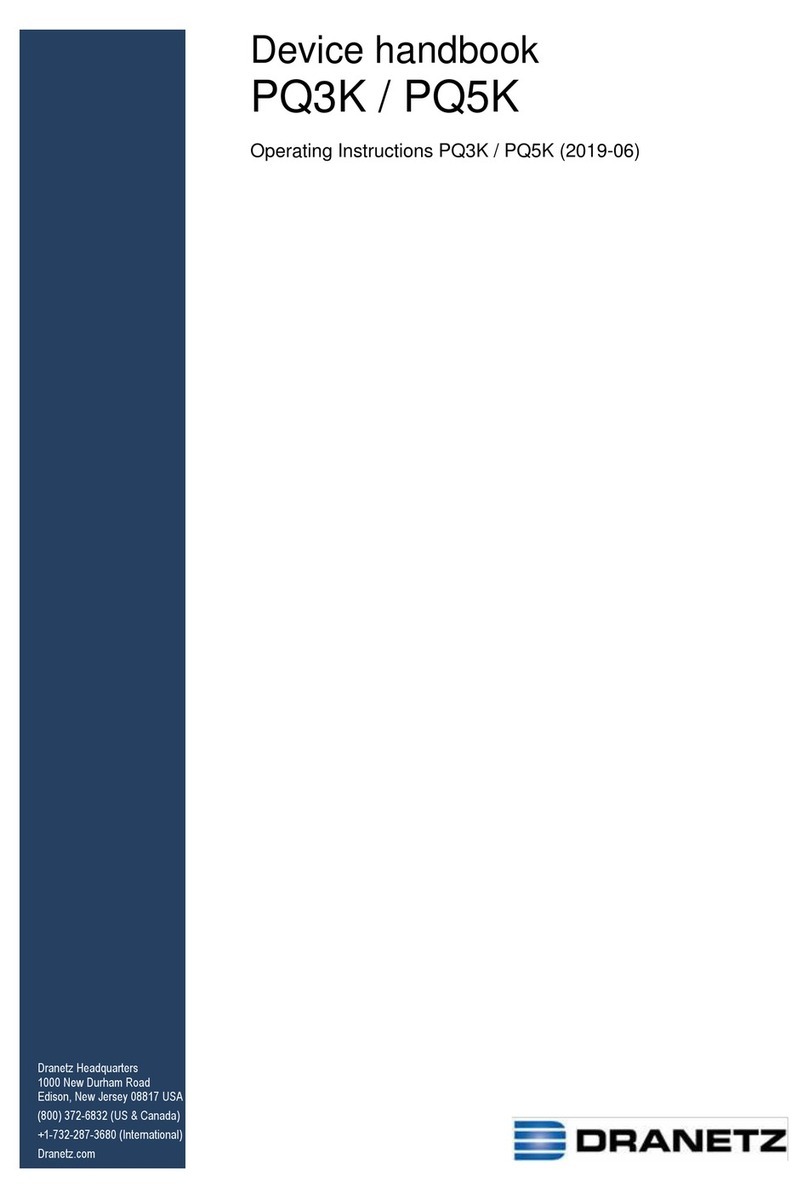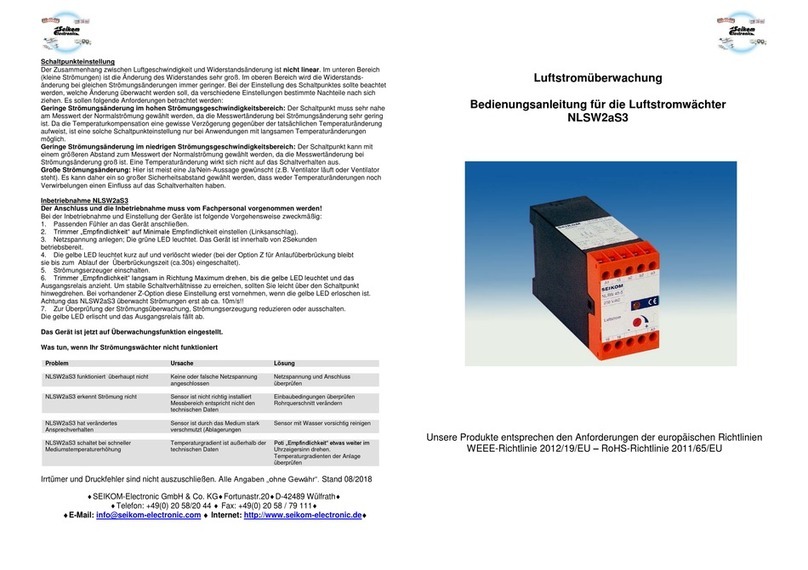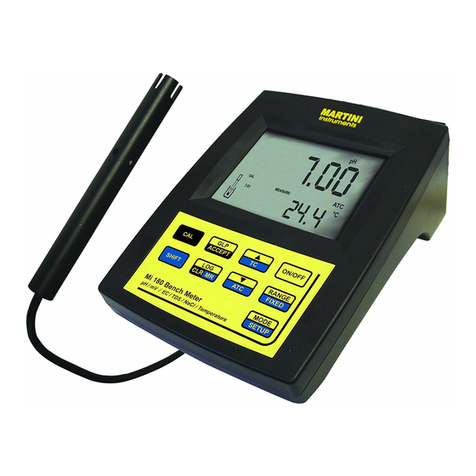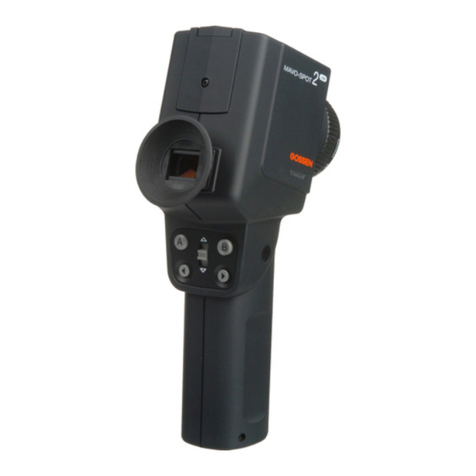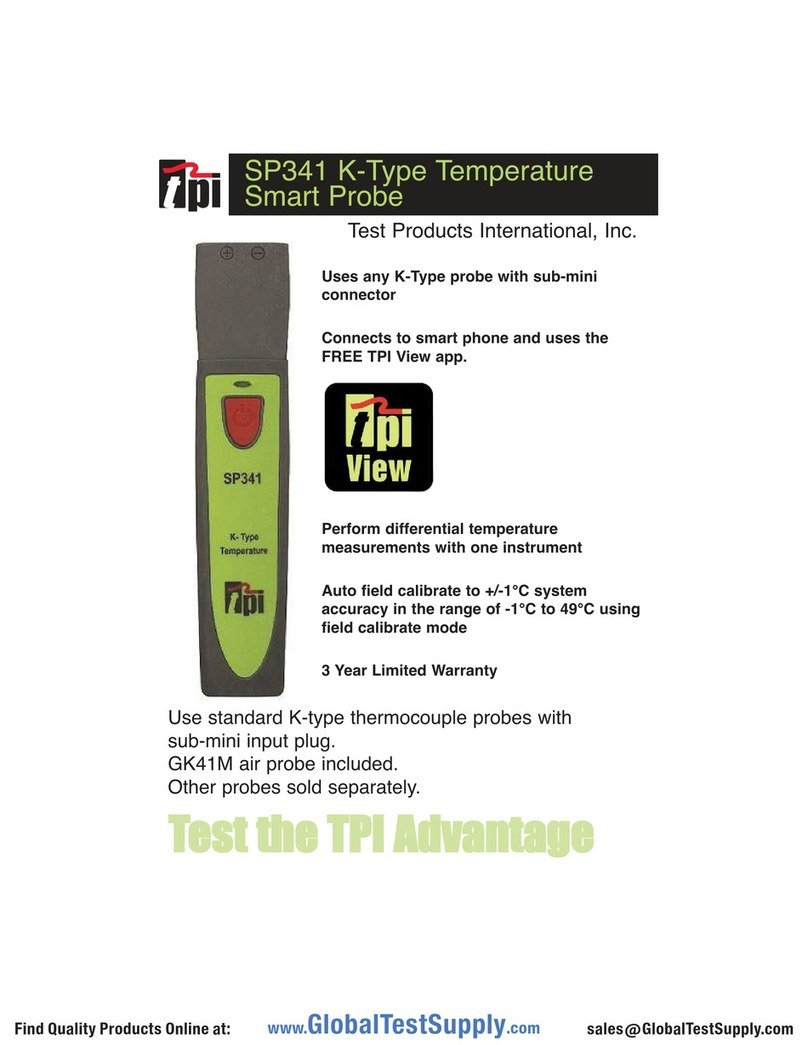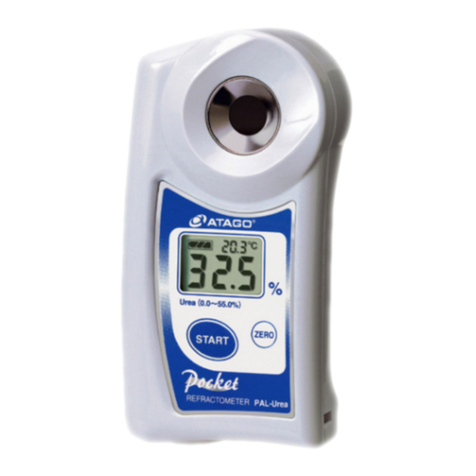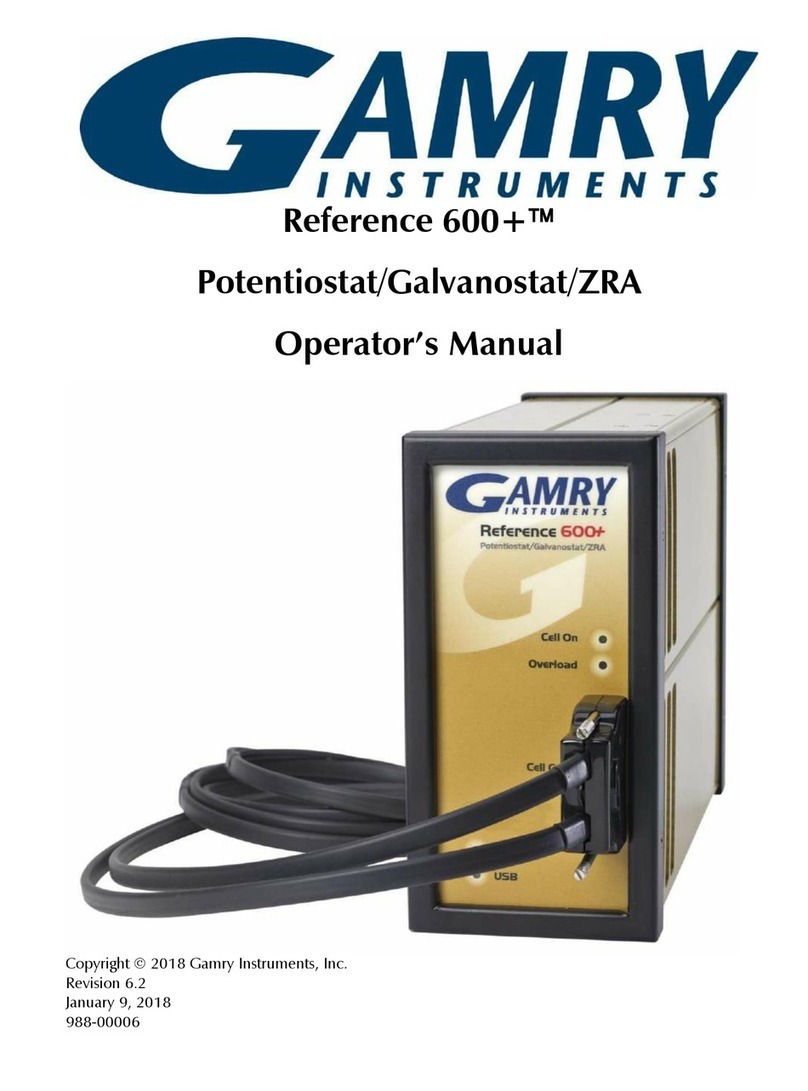GM INSTRUMENTS Naris User manual

Naris
Naris User’s Manual V14 14/02/20 Page 1 of 52
Naris
User Manual
V14

Naris
Naris User’s Manual V14 14/02/20 Page 2 of 52
TABLE OF CONTENTS
NARIS SAFETY INFORMATION
NR6 RHINOMANOMETER SAFETY INFORMATION PAGE 4
NR6 RHINOMANOMETER TECHNICAL SPECIFICATIONS PAGE 6
NR6 RHINOMANOMETER TABLE OF SYMBOLS USED PAGE 7
A1 ACOUSTIC RHINOMETER SAFETY INFORMATION PAGE 8
A1 ACOUSTIC RHINOMETER TECHNICAL SPECIFICATIONS PAGE 10
A1 ACOUSTIC RHINOMETER TABLE OF SYMBOLS PAGE 11
INSTALLATION PAGE 13
INTRODUCTION TO MEASUREMENT TECHNIQUES PAGE 15
HOW TO MAKE AND RECORD MEASUREMENTS
RHINOMANOMETER OVERVIEW PAGE 16
PERFORMING A MEASUREMENT PAGE 18
PERFORMING A TEST PAGE 19
COMMON PROBLEMS AND TROUBLESHOOTING PAGE 24
ACOUSTIC MEASUREMENTS PAGE 25
MAKING MEASUREMENTS PAGE 27
FACTORS WHICH AFFECT ACCURACY PAGE 28
ENVIRONMENTAL FACTORS PAGE 29
MAINTENANCE
MICROPHONE AND TRANSDUCER DIAGNOSTICS PAGE 30

Naris
Naris User’s Manual V14 14/02/20 Page 3 of 52
A1 TROUBLESHOOTING PAGE 32
A1 SPARE PARTS AND ACCESSORIES PAGE 38
CLEANING AND DECONTAMINATION PAGE 39
A1 ACOUSTIC RHINOMETER CALIBRATION PAGE 40
A1 ACOUSTIC RHINOMETER ROUTINE MAINTENANCE PAGE 40
NR6 RHINOMANOMETER CALIBRATION PAGE 41
NR6 RHINOMANOMETER MAINTENANCE PAGE 42
NR6 SPARE PARTS AND ACCESSORIES PAGE 44
APPENDIX 1: GUIDANCE ON THE ELECETROMAGNETIC PAGE 46
ENVIRONMENT IN WHICH TO OPERATE THE INSTRUMENT
APPENDIX 2: TECHNCIAL INFORMATION (relative to EN 60601-1:2006) PAGE 48
APPENDIX 3: CARE OF FLOWHEADS PAGE 50
APPENDIX 4: DEFINITIONS FOR CLEANING/DISINFECTING/STERILIZING PAGE 52

Naris
Naris User’s Manual V14 14/02/20 Page 4 of 52
NARIS SAFETY INFORMATION
NR6 RHINOMANOMETER SAFETY INFORMATION
Read this Operating Manual before attempting to use the
Instrument.
WARNINGS
This instrument is for indoor use only and it should be used as described in this manual.
The system must not be used in the presence of flammable gases or in an environment which
is susceptible to explosions (Beware of oxygen, dust, and anaesthetic gases)
To avoid risk of electric shock, the PC, if connected to a mains supply must be connected to a
mains supply with a protective earth.
The unit is a PC-connected product. It is advisable not to touch the patient whilst using the
equipment.
The equipment should be positioned in such a way that it can be easily disconnected from a
mains-powered PC. The operation of the system can be safely terminated by switching off the
PC, or removing the USB cable between the PC and the NR6
If your PC or printer does not have a power supply approved for a patient environment, then
an isolation transformer, which complies with BS EN 60601-1, should be used to power the PC,
Printer. You must use the transformer or run the PC by battery to ensure that the NR6 is in
compliance with BS EN 60601-1.
Applied Parts. The applied parts consist of single-use foam inserts, microfoam tape, tip
connectors, anterior or posterior tubing, masks (single-use /or reusable) connected to an
antiviral filter, flowheads and silicon rubber tubing.
CAUTIONS
Patient connection components may cause an irritation reaction in some patients. Use of
such components should be discontinued in patients who exhibit such a reaction.
Certain components are identified as single-use items. Single-use items should not be
reused as they could carry infections between subjects
Federal (USA) law restricts this device to sale by or on the order of a physician.
The use of an NR6 Rhinomanometer near to sources of electromagnetic radiation, such as
mobile phones, radio transmitters, x-ray equipment etc, may prevent it from functioning

Naris
Naris User’s Manual V14 14/02/20 Page 5 of 52
correctly. Appendix 1 provides guidance on the Electromagnetic environment in which to
operate the instrument.
The NR6 Rhinomanometer is a medical instrument, which has an electrical classification of
Class I Type B and a Medical Device Directive Classification of Class I with a measuring
function.
A Class I Type B device categorisation is used to describe an instrument which:
a) Does not rely on basic insulation only to provide protection against electrical shock but is
constructed in such a way that accessible metal parts cannot become live in the event of
failure of the basic insulation, and
b) Applied parts offer protection to the subject against electrical shock and in the event of a
single fault condition arising, leakage current will be limited to less than 0.5 mA.
Any incident, which results in actual or potential injury or death to a subject while using an
NR6, should be immediately communicated to GM Instruments at the address on page 7.
NR6 should only be connected to other mains-powered devices such as computers and
printers, which comply with EN 60950-1 and we also advise the use of a separating
transformer. Unless computers and printers built to EN 60950 are used, patient safety might
be compromised.
Non-medical equipment such as computers and printers should be kept out of reach of
subjects being tested as such equipment does not comply with medical safety standards.
Refer to clause 16 of EN 60601-1:2006 to ensure compliance.
If the PC is allowed to go into sleep mode, the USB interface is powered down. When brought
out of sleep mode, the PC does not re-initialise the USB interface, and therefore it is effectively
not present. A solution is to remove the USB connection at the PC or instrument side then re-
connect. That may be sufficient, but if not - save any results, then close down the instrument
software and restart it.
Servicing can only be carried out by GMI approved and
authorised personnel. No modifications are allowed.
Storage
The A1/NR6 and its accessories should be stored within the following temperature and
humidity ranges:
Temperature -40 oC to +60 oC
Humidity 20% to 80% RH non-condensing
Pressure 50 kPa to 106 kPa

Naris
Naris User’s Manual V14 14/02/20 Page 6 of 52
Standardisation Document:
Customers are referred to the under-noted publications which contain recommendations on
the use of Rhinomanometers.
Committee report on Standardisation of Rhinomanometry. Rhinology 1984:Vol 22, 151-
155.
NR6 RHINOMANOMETER TECHNICAL SPECIFICATIONS
Only factory-trained personnel or engineers familiar with the standard EN 60601 can
undertake servicing of the NR6 Rhinospirometer.
Circuit diagrams will be made available to competent persons on request
Medical CE Mark
The CE mark indicates that the device meets the requirement of
Annex V & VII of the Medical Device Directive 94/42/EEC
Standards
Safety
BE EN 60601-1 :2006
EMC
BS EN 60601-1:2007
Performance
Flow Range
+/- 800 cc/sec
Pressure Range
+/- 800 Pa
Accuracy
+/- 2%
Operation Environment
Temperature
+15 o C to +35 C
Relative
Humidity
20% to 80% RH non-condensing
Pressure
50 kPa to 106 kPa
Duty Cycle
Continuous
Warm Up Time
5 minutes
Supply
USB taken from PC
Transportation and Storage
Temperature
-40 °C to +60 °C
Relative
Humidity
20% to 80% RH non-condensing
Pressure
50 to 106 kPa
Mechanical Performance
Size
27 x 8 x 30 cm
Weight
2 Kg

Naris
Naris User’s Manual V14 14/02/20 Page 7 of 52
TABLE OF SYMBOLS USED
The following symbols appear on the NR6
Symbol
Meaning
Socket Type
Location
Connected Part
Refer to
Instruction Manual
ISO7010-M002
USB Connector
Type B
Instrument Back
Panel
Computer
(Via USB port)
Type B
Applied Parts
IEC 60417- 5840
Tubing Connectors
Flow and Pressure
Instrument Front
Panel
Flow head
Assembly
Protective Earth
IEC 60417 - 5019
_
Instrument Back
panel - Internal
_
For connected parts marked * only connect the accessories supplied with
the instrument. These parts have been tested for use with the instrument
for compliance to standards IEC 60601-1 and IEC 60601-1-2.
Symbols used on labelling and packaging, as for A1, but with the following additions:
Symbol
Meaning
Location
Do not re-use
IEC7000-1051
Consumables
Packaging- Filter, Nasal
Inserts
Non- sterile
ISO7000-2609
Applied parts
packaging- Flowhead
Assembly

Naris
Naris User’s Manual V14 14/02/20 Page 8 of 52
A1 ACOUSTIC RHINOMETER SAFETY INFORMATION
Read this Operating Manual before attempting to use the
Instrument.
WARNINGS
This instrument is for indoor use only and it should be used as described in this manual.
The system must not be used in the presence of flammable gases or in an environment
which is susceptible to explosions - beware of oxygen, dust, and anaesthetic gases.
To avoid risk of electric shock this equipment must be connected to a mains supply with a
protective earth.
If your desktop PC or printer does not have a power supply approved for a patient
environment, then an isolation transformer, which complies with BS EN 60601, should be
used to power the PC, printer, and the A1 Acoustic Rhinometer. You must use the isolation
transformer to ensure that the A1 Acoustic Rhinometer is in compliance with BS EN 60601.
As this is a mains-powered, PC-connected product it is advisable to not touch the patient
while using the equipment.
The equipment should be positioned in such a way that it can be easily disconnected from
the mains supply. The operation of the system can be safely terminated by switching off the
device or removing the mains plug.
The applied part is the nosepiece, which is marked for single use. It should not be re-used,
as no method of sterilisation can be guaranteed - disinfection materials may not be effective
and may leave a residue, which could be harmful.
CAUTIONS
The nosepieces are made of a material, which may cause an irritation reaction in some
patients. Use of the nosepieces should be discontinued in patients who exhibit such a
reaction.
Nosepieces are a single-use item. Single-use items should not be reused as they could
transfer infections between subjects.
Federal (USA) law restricts this device to sale by or on the order of a physician.
The use of an A1 Acoustic Rhinometer near to sources of electromagnetic radiation, such as
mobile phones, radio transmitters, x-ray equipment etc., may prevent it from functioning
correctly.

Naris
Naris User’s Manual V14 14/02/20 Page 9 of 52
The A1 Acoustic Rhinometer is a medical instrument, which has an electrical classification of
Class l Type B and a Medical Device Directive classification of IIa.
A Class l Type B device categorisation is used to describe an instrument which:
a) Does not rely on basic insulation only to provide protection against electrical shock but is
constructed in such a way that accessible metal parts cannot become live in the event of
failure of the basic insulation, and
b) Applied parts offer protection to the subject against electrical shock and in the event of a
single fault condition arising, leakage current will be limited to less than 0.5 mA.
Any incident, which results in actual or potential injury or death to a subject while using an
A1 should be immediately communicated to GM Instruments at the address on page 6.
An A1 should only be connected to other mains-powered devices such as computers and
printers, which comply with EN 60950-1 and we also advise the use of a separating
transformer. Unless computers and printers built to EN 60950 are used, patient safety might
be compromised.
Non-medical equipment such as computers and printers should be kept out of reach of
subjects being tested as such equipment does not comply with medical safety standards.
Refer to clause 16 of EN 60601-1:2006 to ensure compliance.
If the PC is allowed to go into sleep mode, the USB interface is powered down. When brought
out of sleep mode, the PC does not re-initialise the USB interface, and therefore it is effectively
not present. A solution is to remove the USB connection at the PC or instrument side then re-
connect. That may be sufficient, but if not, save any results, then close down the instrument
software and restart it.
Servicing can only be carried out by GMI approved and
authorised personnel. No modifications are allowed.
Storage
The A1 Acoustic Rhinometer and its accessories should be stored within the following
temperature and humidity range:
Temperature -40°C to + 60°C
Humidity 20 to 80% RH non-condensing
Pressure 50 kPa to 106 kPa

Naris
Naris User’s Manual V14 14/02/20 Page 10 of 52
Standardisation Document
Customers are referred to the under noted International Standardisation Committee
publication which contains recommendations on the use of Acoustic Rhinometers.
Acoustic Rhinometry: Recommendations for technical specifications and standard
operating procedures.
Rhinology supplement number 10, December 2000
Ole Hilberg and Ole Pedersen
A1 ACOUSTIC RHINOMETER TECHNICAL SPECIFICATIONS
Only factory-trained personnel or engineers who are familiar with the standard EN 60601
can undertake servicing of the A1 Acoustic Rhinometer.
Circuit diagrams will be made available to competent persons on request.
Medical CE Mark
The CE mark indicates that the device meets the requirement of
Annex V & VII of the Medical Device Directive 94/42/EEC
Standards
Safety
BE EN 60601-1 :2006
EMC
BS EN 60601-1:2007
Performance
(using standard nose)
Repeatability
Better than 2%
Volume
Accuracy (0cm
to 5cm)
Better than 2%
Minimum Area
Accuracy
(within 0cm to
5cm)
Better than 5%
Area Range
(max 20,
default 10)
0.1 cm2to 10 cm2
Distance Range
(using standard
sound tube)
0 cm to 12 cm
Calibration
Self - calibrating
Operation Environment
Temperature
+15 o C to +35 C
Relative
Humidity
20% to 80% RH non-condensing
Pressure
50 kPa to 106 kPa
Duty Cycle
Continuous
Warm Up Time
5 minutes
Supply
Universal voltage –external supply
Power
10 Watts
Transportation and Storage
Temperature
-40 °C to +60 °C
Relative
Humidity
20% to 80% RH non-condensing
Pressure
50 kPa to 106 kPa
Mechanical Performance
Size
27 cm x 8 cm x 30 cm
Weight
2 Kg

Naris
Naris User’s Manual V14 14/02/20 Page 11 of 52
TABLE OF SYMBOLS USED
The following symbols appear on the A1 or the mains adaptor:
Symbol
Meaning
Socket Type
Location
Connected Part
Refer to
Instruction Manual
ISO7010-M002
USB Connector
Type B
Instrument Back
Panel
Computer
(Via USB port)
5-Pin Din Socket
Instrument Back
Panel
Mains AC/ DC
Adaptor
PCM50UT04*
Type B
Applied Parts
IEC 60417- 5840
JIS C 5432-
Compliant
5-Pin Socket
Instrument Front
Panel
Sound Tube
Protective Earth
IEC 60417 - 5019
_
Instrument Back
panel - Internal
_
Direct Current
IEC 60417 - 5931
_
Mains Adaptor
AC/DC
_
For connected parts marked * only connect the accessories supplied with
the instrument. These parts have been tested for use with the instrument
for compliance to standards IEC 60601-1 and IEC 60601-1-2.
Symbols used on labelling and packaging:
SYMBOL
MEANING
LOCATION
Manufacturer
ISO7000-3082
Instrument Label
Date of Manufacture
Where ZZZZ: Date of Manufacture
ISO7000-2497
Instrument Label
Serial Number
ISO7000-2498
Instrument Label

Naris
Naris User’s Manual V14 14/02/20 Page 12 of 52
Consult Instructions for Use
ISO7000-1641
Instrument Label
Council Decision 93/465/EC. Annex B(d)
Instrument Label
Do not re-use
IEC7000-1051
Consumables
Packaging- Nosepieces
Non- sterile
ISO7000-2609
Applied parts
packaging- Nosepieces
Temperature Limit
ISO7000-0632
Instrument Shipper
Packaging
Humidity Limitation
ISO7000-2620
Instrument Shipper
Packaging
Mandatory Action Sign
ISO 7010- M001
Operating Manual
ADDRESS AND CONTACT DETAILS:
MANUFACTURED BY:
G M INSTRUMENTS LTD,
GREIG HOUSE
ANNICKBANK INNOVATION CAMPUS,
ANNICK ROAD,
IRVINE,
KA11 4LF,
UK
TEL: +44 (0)1294 55466
WEBSITE: www.gm-instruments.com

Naris
Naris User’s Manual V14 14/02/20 Page 13 of 52
INSTALLATION
SOFTWARE
Installation of the NR6 Software is described fully in the accompanying manual titled “NARIS
Software Manual”
INSTALLING THE NARIS HARDWARE
NR6 HARDWARE CONNECTIONS
Please see the pictures below for the NR6 hardware connections:
NR6 front view - flowhead and Back panel view showing a link
pressure connections cable socket to A1 and USB socket
The NR6 box has four nozzles on it, which are colour coded: Black is the pressure input, Blue
is the pressure reference, Red is the positive flow input, Green is the negative flow input.
Connect each tube onto the input nozzle with the corresponding coloured marker, i.e. black
-> black, red -> red etc.
Connect the free ends of the tubes to their corresponding coloured markers –green and red
tubes onto the green and red nozzles on the flowhead, and the tube marked blue onto the
mask port marked blue. If you are going to be making posterior tests, the tube marked black
will also go onto the mask nozzle marked black, but if you are going to make anterior
measurements, it will go onto an anterior tube connector. In this case the mask nozzle
marked black should be closed, using the plug provided
A1 HARDWARE CONNECTIONS
SOUND
TUBE
SOCKET
POWER SOCKET
FROM PCM5OUT04

Naris
Naris User’s Manual V14 14/02/20 Page 14 of 52
A1 back panel view showing USB socket, which connects to the PC, a link socket, which
connects to an NR6 link socket, the sound tube socket, the power socket, and the relevant
manufacturing labels.

Naris
Naris User’s Manual V14 14/02/20 Page 15 of 52
INTRODUCTION TO MEASUREMENT TECHNIQUES
Hardware and software has been provided to allow for:
1) the determination of Nasal Area-Distance plots by acoustic reflection
2) the determination of Nasal Airway Resistance by the measurement of flow and
pressure signals
The Acoustic method is based on the following principle:
A sound pulse propagates in a tube and enters the nasal cavity through a nosepiece, where
it is reflected by local changes in cross-sectional area. The incident and reflected signals are
then measured by a microphone in the sound tube.
From these measurements, it is possible to calculate the cross-sectional area as a function
of the distance into the cavity by use of algorithms developed by Ware and Aki (1969).
By integration of this curve the volume of the nasal cavity is calculated.
The method has been developed for use in the tracheo-bronchial system by Jackson et al.
(1977), and for use in the nose by Hilberg et al.(1989).
For further information, the reader should consult these publications:
1. A.C. JACKSON, J.P. BUTLER, E.J. MILLET, F.G. HOPPIN JR., AND S.V. DAWSON. Airway
geometry by analysis of acoustic pulse response measurements. J. Appl. Physiol. 43(3):523-
536,1977.
2. J.A. WARE, AND K. AKI. Continuous and discrete inverse scattering problems in a
stratified elastic medium. I. Plane waves at normal incidence.
J. Acoust. Soc. Am. 45:911- 921,1969.
3. O. HILBERG, A.C. JACKSON, D.L. SWIFT, AND O.F. PEDERSEN. Acoustic
Rhinometry, evaluation of nasal cavity geometry by acoustic reflection. J. Appl. Physiol.
66:295303,1989.
The principals of Rhinomanometry are very well known and have been described in many
papers, but at its simplest a rhinomanometer measures nasal flow and the pressure
required to produce that flow.
The calculation techniques, which are used to present relevant numerical information from
the flow and pressure signals, are described in the rhinomanometry standardisation paper.

Naris
Naris User’s Manual V14 14/02/20 Page 16 of 52
HOW TO MAKE AND RECORD MEASUREMENTS
Two methods of acquiring data are provided within the Naris software: rhinomanometric
acquisition, and acoustic acquisition.
These are described separately in the sections below.
RHINOMANOMETER OVERVIEW
The measure of rhinomanometry or nasal airway resistance (R) depends on measuring nasal air
flow (F) and the pressure (P) producing that airflow:
Nasal airflow is collected by a mask, which must form an airtight seal around the face, and is
then passed out through a pneumotachograph head in which the flow is converted to a
pressure differential. This differential is transmitted to the NR6 by means of the tubes marked
with red and green bands.
Nasal pressure is the more difficult parameter to measure and this is done using one of two
standard techniques:
ANTERIOR TEST (detailed on P12)
In the anterior test the black pressure tube is connected to one side of the nose while airflow is
measured through the other side, allowing for resistance to be calculated on that side. The
pressure tube is then moved to the second side, flow is recorded, and resistance is calculated
again. The two resistance values are then put into the formula below to calculate total
resistance:
The pressure connection to the nose is made by either:
•a tip connector pushed through a small hole punched in microfoam tape, or a foam
insert
•linked to the black pressure tube using anterior tubing and an anterior connector.
The reference pressure tube (blue) is connected to the mask.
It is essential that the pressure connection is airtight, and this should be checked by:
1) Connecting the anterior tubing to the side of the nose which is not being measured
1 = 1 + 1
R TOTAL R LEFT R RIGHT

Naris
Naris User’s Manual V14 14/02/20 Page 17 of 52
2) Holding or taping the free end of the anterior tubing against the soft part of the
subject’s cheek
3) Asking the patient to obstruct the free side of their nose with a finger while you block
the free end of the anterior tube. If the patient tries to gently breathe in and out
through their nose they will be able to tell you if they feel any air leakage at the tape or
foam connection to their nose.
4) Having achieved no leakage, and without moving the anterior tube, carefully place the
mask on the face, starting just above the bridge of the nose, and ask the subject to hold
the mask in place.
Connect the free end of the anterior tube to the black ringed pressure tube from the NR6,
using the anterior connector.
POSTERIOR TEST (detailed on P 15)
In the posterior test, a length of posterior tubing is connected onto the black nozzle inside the
mask–cut just long enough to sit on the tongue - and the lips closed round the tube. Provided
the soft palate is relaxed, the pressure measured by this mouth tube will be the same as the
pressure driving airflow through the nose. This pressure signal is taken to the NR6 by means of
the tube with the black ring marker on it, which is connected to the black nozzle on the outside
of the mask. The reference pressure tube (blue) is also connected to the outside of the mask.
Patient co-operation is required to use this technique, in which a measure of total nasal
resistance is obtained from one test.
PRINCIPAL POINTS TO NOTE
1) Prepare the patient by having them wait in relaxed quiet conditions for 15 to 20 minutes
prior to measurements being taken, and decongest them
2) Check for leakage of the pressure tube and for good mask fit
3) Ask the patient to breathe in a quiet relaxed way - avoid excited, rapid manoeuvres
Posterior and Anterior tests can be performed using a fixed reference level (selectable from 75
Pa to 300 Pa) or, alternatively, under the Broms technique with a radius of 200 units. In either
case, resistance is calculated when the trace crosses the fix line or arc of the circle.
The recommended reference points are as follows:
Standard posterior 75 Pa
Standard anterior 150 Pa
Broms 200 units
It is recommended that resistance values be averaged over at least 4 breaths, and as such is
offered by default.
In addition to resistance values, Rohrer coefficients are also calculated for K1 and K2:
K0 should be zero as the curve goes through the origin
K1 represents the laminar flow part of the curve
K2 represents the turbulent part of the curve

Naris
Naris User’s Manual V14 14/02/20 Page 18 of 52
PERFORMING A MEASUREMENT
The program has adopted many standard windows conventions and can be controlled by using
the mouse, function keys, or "hot keys”. Most are self-explanatory but some features may not
be immediately obvious e.g. how to compare one test against another to get % change figures,
or how to mark a group of files for printout. A software guide has been supplied separately to
aid quick referral.
Most errors in Rhinomanometry can be attributed to:
a) POOR PATIENT PREPARATION
Patients should be in a stable environment for 15 - 20 minutes and should be asked to blow
their nose or be decongested prior to testing. They should also be advised to breathe at a
normal level and rate.
b) POOR PATIENT CONNECTION
The pressure tube and mask must not leak and must be placed on the face correctly to avoid
distorting the nose.
Errors arising from a) can be avoided by careful processing of patients prior to testing, and
those arising from b) can be checked by using the batch test facility (Clinical/Research version
only). Essentially, the batch test facility allows rapid retesting of a patient with automatic
comparison of one of the measured parameters and production of mean, standard deviation
and coefficient of variation figures for the test runs repeated for that patient.
The process to be followed is therefore:
•connect and test patient
•disconnect patient
•reconnect and retest patient.
Continue this process until the CV figure drops to an acceptable level.

Naris
Naris User’s Manual V14 14/02/20 Page 19 of 52
PERFORMING A TEST
The patient should be connected to the instrument only when the screen shows the flow and
pressure axes,and after checking that the dot lies on the origin of the graph. If the system is
not correctly zeroed, while no subject is connected, press Zon the keyboard, or click on the
Zero button.
a) ANTERIOR METHOD
The anterior test requires no patient co-operation and can therefore be performed on any
subject. The technique requires that one side of the nose be used as an extension to the
pressure tube (to monitor the pressure component relative to the mask pressure) and this
connection is achieved using either:
1) Microfoam tape, a tip connector, anterior tubing, and an anterior connector, or
2) A foam insert, anterior tubing, and an anterior connector
The black mask-mounted connector should be sealed during the anterior method, as it is not
required.
In this method flow is measured on the open nostril. The mouth should be closed during the
test and once the resistance figure for one side has been obtained, the role of the nostrils is
reversed by moving the tape assembly or foam insert to the other nostril.
It is a fundamental requirement of this technique that an airtight connection of the instrument
pressure tube onto one side of the nose be made with as little distortion as possible. Satisfying
this criterion results in the best possible accuracy.
N.B If foam inserts are to be used, substitute the foam insert for the tip connector and tape as
shown below.
ANTERIOR TEST PREPARATION
a) make a hole in the tape using TIP CONNECTOR
the smallest die on the punch
supplied
b) fit a tip connector and 15 cm
of anterior tubing to the tape TAPE
as shown (or 15 cm of anterior tubing
onto a foam insert).
De-grease the nose with an
appropriate agent such as SILICONE
surgical spirit ANTERIOR TUBING
c) fix the tape onto the nose (or foam into FOAM INSERT
the nose), position the tube against (alternative to tape/Tip)
the cheek where it will be during the test,
and check for leakage by blocking the

Naris
Naris User’s Manual V14 14/02/20 Page 20 of 52
free end of the tube with your
finger, ask the subject to block
their open nostril with their thumb and gently breathe in and out through their nose –
they will feel any leakage
d) if airtight, secure the tube in this position by bringing the mask up to the face, taking
care to position it on the bridge of the nose and ask the patient to hold the mask
assembly there (see page 22 for
pictures)
e) connect the anterior tubing’s
free end to the pressure tube
(marked black) using
the anterior tube connector
f) ask the patient to maintain
pressure on the mask to
achieve an airtight seal
while closing their lips and
breathing through their nose.
Ensure that the patient’s
fingers do not obstruct the
output from the flowhead
There are two principal hazards associated
with this technique:
a) The patient could press so hard that the
anterior tube collapses and is obstructed
completely - this will result in the display showing an almost vertical line and can be corrected
by asking the patient to apply a little less pressure
b) If the respiratory rate is too high there will be a tendency to create an open loop on the
display. In the event of this occurring, the patient should be given time to become familiar
with the mask and then asked to breathe more slowly
Mask assembly for anterior testing
Table of contents
Other GM INSTRUMENTS Measuring Instrument manuals
